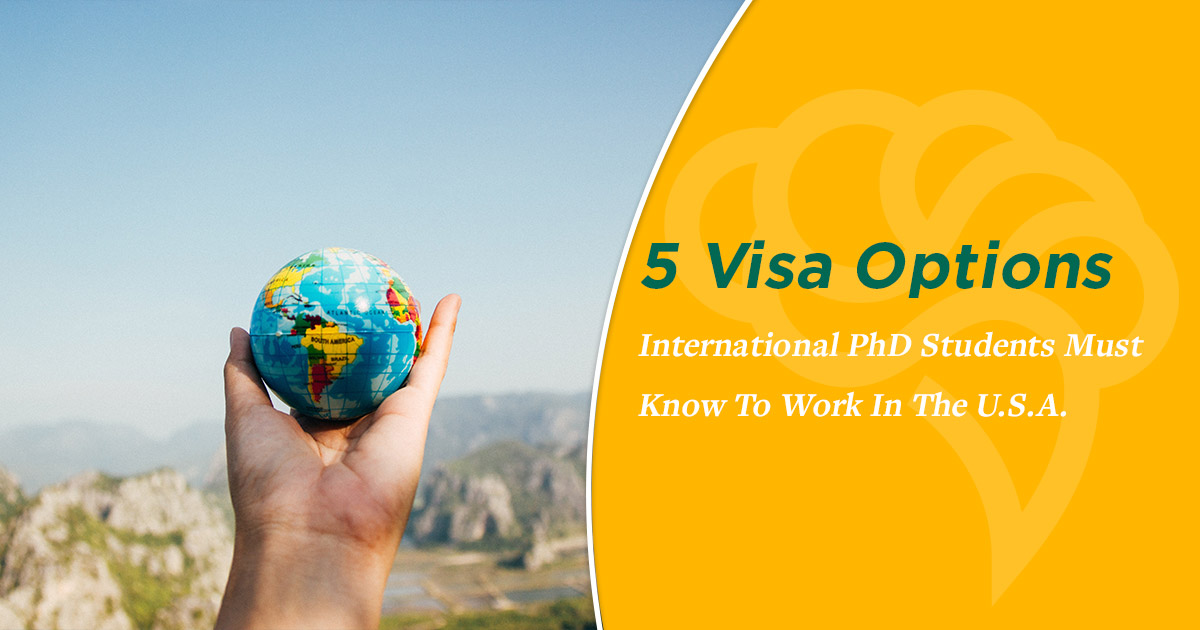5 Visa Options International PhD Students Must Know To Work In The U.S.A.

Like most PhD students preparing to graduate, I started applying for jobs early.
I felt lucky to receive some positive responses right away.
In a very short period of time, I had interviews lined up with 4 different companies.
I went through multiple rounds of interviews, and even reached the stage of salary negotiation in 3 of these cases.
It all seemed to be going well.
Being proactive was paying off and now I was going to have a new job lined up before graduation.
So easy!
Too easy.
It didn’t take long for all 3 companies to retract their job offers.
All with similar vague and robotic responses that they decided to go a different route.
What?
I thought I was a shoe-in for at least one of them!
I had received positive feedback from every person I met and I followed all the proper interview etiquette, down to the personalized thank-you letter.
I had done everything right.
Meanwhile, graduation was just around the corner and anxiety was building around my immigration status.
The immigration law states that international students attending school in the U.S. must have full-time employment within 90 days of graduation.
Three months might sound like ample time — but it’s not.
Getting a response after submitting your industry resume, going through multiple rounds of interviews, and then eventually receiving a job offer often takes much longer than 3 months.
I frantically applied to more positions and networked as much as possible with industry professionals.
Fortunately, about a month after my graduation, I caught my break and landed a job.
I accepted the offer even though it wasn’t my first choice and the starting salary was lower than what I would have preferred.
But waiting wasn’t an option, given the 60 days I had left, and I couldn’t risk holding off and looking into other companies with the immigration laws looming overhead.
I didn’t realize that the reason offers were retracted or withheld was because I was an international student.
The employers did not want to deal with the hassle of additional immigration paperwork when they could hire someone equally as qualified with American citizenship.
I might have been the right choice, but I was the harder choice, so someone else got the job.
Getting chosen over a U.S. citizen — or someone with established permission to work in the U.S. — is an uphill climb.
It’s so much easier for companies to go with a simple hire without the paper trail process they perceive as being time-consuming and uncertain.
My story is not unique.
It has been 3 years since I graduated.
I do not regret the first industry job I accepted but I wish someone had prepared me for the challenges I would face as an international student.
Why International PhDs Must Know Visa Policy
According to a report by the Global Cities Initiative in 2014, the number of foreign students on F1 (student) visas in U.S. colleges and universities grew dramatically from 110,000 in 2001 to 524,000 in 2012, two-thirds of which study STEM and business fields.
45% of foreign student graduates extend their visas in order to remain in the same area as they studied.
And the trends show that international students can provide benefit to key metropolitan areas and can strengthen local economies.
Each fiscal year, the Migration Policy Institute reported that 55,000 diversity visas — otherwise known as green cards — are made available as part of a lottery system.
The demand for lottery visas is always much higher than the amount that are made available.
Like any lottery, the odds are not guaranteed and often slim.
In the 2016 program, close to 11.4 million qualified applicants were registered for the lottery, a 21% increase from the prior year.
Sound overwhelming?
You are not alone.
There are thousands of PhDs in your shoes, wanting to transition out of academia but struggling with visa requirements.
As a foreign PhD student, you have benefits that you need to leverage along with your knowledge of immigration policy.
Treat this like one of your courses you need to master so you can present yourself in the best light.
You have to arm yourself with knowledge.
Know your options.
Know your facts.
Get professional advice.
Only then can you start to properly prepare and strategize for your career transition.
If you want a company to sponsor you for a visa, you need to show that you are above and beyond any other available candidate.
You need to leverage your value to the company in ways that make your immigration status seem trivial.
Do the homework for them in terms of what visa you will need and the process that is involved.
Make it easy for them to hire you.

5 Visa And Citizenship Options For International PhDs
The American immigration process is not for the faint of heart or the impatient.
It’s an established system placed under high demand and strict policy.
This adds stress and frustration to your graduation process because it is so uncertain.
Multiple visa options exist and trying to sift through the best approach for you requires diligence, professional advice, and strategy.
The details of the steps and time taken to complete them will vary based on what kinds of jobs you apply for, whether you have relatives in the U.S., and which country you come from.
You should always seek help from legal professionals to ensure successful completion of immigration procedures.
Here are 5 of the most common visa options international PhD students must know to help get an early advantage while focusing on your career transition…
1. F1-OPT.
If you came to the U.S. as a graduate student, you must have started out on an F1 visa, also known as a student visa.
Once you are close to graduating from your program, you should apply for OPT (Optional Professional Training) through your school’s international student services office in order to be permitted to stay and work in the U.S.
The average time required to get an OPT from the United States Citizenship and Immigration Services (USCIS) is 1-2 months.
IMPORTANT: Be careful when you apply to maximize the number of days that you have available following graduation.
Keep in mind that you will need to find full-time employment within 90 days of the start date printed on your OPT card.
Best case scenario is that you have something lined up before you graduate and are conscious of your start date.
You can find more detailed information about OPT at the USCIS website.
2. F1-OPT extension.
Your OPT will typically be valid for 12 months.
Those who graduate from an American university STEM program are eligible to apply for an extension of OPT if they have not already applied for another visa status.
Prior to May 10th, 2016 this extension was only valid for 17 months but has since been increased to 24 months.
In order to be eligible for this extension, you have to meet two criteria.
First, you should be employed in a field associated with your field of study, and second, your employer should be enrolled in the e-verify program.
Find out more details about the e-verify program and even check if a company is registered in this program here.
3. J1 visa.
This will be your most likely visa status if you decide to do a postdoc in academia after your PhD.
The official term used for this category is “work-and-study-based exchange visitor programs” and is reserved for non-profit or educational institutions.
Your institution must be accredited with the Exchange Visitor Program through the U.S. State Department.
Multiple programs exist and qualify under the J1 visa and the application must be sponsored by the institution.
The university where you are doing your postdoctoral research will apply for your J1 visa to the U.S. State Department’s Bureau of Educational Cultural Affairs.
4. H1B visa.
This category of visa will typically be your option if you start a job in industry after your PhD, while you are still on OPT.
Your employer, whether in industry or academia, will have to sponsor your application for H1B to the USCIS.
Although you can get H1B through both academic and non-academic jobs, there are a few differences between them.
The H1B offered to academic positions, such as international postdoctoral scholars, falls under the cap-exempt H1B.
In order to be eligible for cap-exempt H1B, you should be employed by a “not-for-profit institution of higher education”, which covers all employees of universities.
The first obvious difference — as suggested by the name — is that there is no cap/quota in the number of applications, unlike non-academic H1B submitted through private companies.
As a result, you will not have to go through a lottery to be selected if you are a postdoc and your application is submitted by the university.
However, H1B offered by academia does not allow you to switch directly to employers in industry.
If you want to join a company after a few years as a postdoc, and you have a cap-exempt H1 visa, you will need to go through the lottery.
IMPORTANT: The cap for H1B visas is often reached within days.
The lottery requires further screening of relevant documents and waiting at least a few months to receive your approval from USCIS before you can officially receive H1B and become eligible to work for your employer.
5. Green card.
A green card gives you a more permanent status compared to J1 or H1 visas and it also makes it a lot easier to change jobs.
Everything else is a temporary fix for your immigration woes that can serve to extend your time while you work towards this.
Once you have a green card, your next employer will not have to do any immigration paperwork similar to what they will need to do to hire a professional on H1B.
There are several pathways to securing a green card, and exploring all the possibilities are beyond the scope of this article.
But the vast majority of STEM PhDs generally take two possible routes to securing a green card: the EB-1 or EB-2 category.
The EB-1 category is further divided into the following two types: EB-1A for extraordinary ability and EB-1B for applicants who can be classified as outstanding researchers.
Depending upon your professional track record, you can be eligible for either as a science PhD.
The advantage of EB-1 is that it has a much shorter waiting time compared to EB-2.
EB-2 visas are given to professionals who are employed full-time in the U.S. and have an advanced degree (Master’s degree or higher).
PhDs will qualify for this category and generally, your employer will have to file the application on your behalf.
As a STEM PhD, it is possible to apply for a residency from either a J1 or H1 status.
However, according to most legal professionals, there are some advantages for filing for permanent residence (green card) while on H1B status rather than when on J1.
Irrespective of which category you fall under and what route you wish to take, the process of applying for and securing a green card requires you to fulfill much more than just having a PhD and the outcome is hard to predict.
It is also expensive, complex, and time-consuming.
As with all of these options, professional legal advice is invaluable before pursuing a green card.
International PhDs do not have an easy ride to full-time employment. You will have to go that extra mile to prove you have what it takes to be the perfect job candidate. Give yourself the time to network and strategize your job search. On top of this, make sure to do your research about the types of visa options available to you. By knowing this information before graduation, you are taking the onus away from the employer to figure out what they need to do to hire you. Speak with a lawyer and start early. You are an incredibly talented PhD, so do not let bureaucracy stand in the way of your transition.
If you’re ready to start your transition into industry, you can apply to book a free Transition Call with our founder Isaiah Hankel, PhD or one of our Transition Specialists. Apply to book a Transition Call here.

ABOUT ARUNODOY SUR, PHD
Arunodoy is a Ph.D. in Integrative Biology and has training in intellectual property, entrepreneurship, and venture capitalism. He also has experience with global biotechnology and biopharmaceutical companies, including clinical trial consulting. Arunodoy is passionate about the translation of academic research to the real world and commercialization of scientific innovation so that it can help solve problems and benefit people. He possesses in-depth understanding of both technological and commercial aspects associated with the life science industry.
More Written by Arunodoy Sur, PhD































